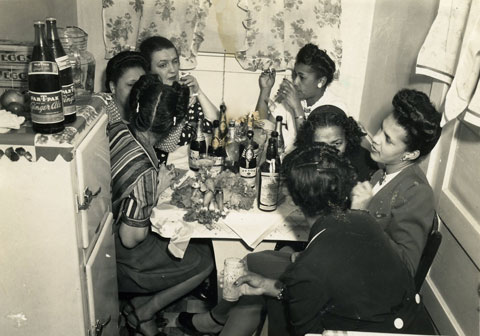In 2010, I was a presenter at the first Bookmark Collectors Virtual Convention, encouraging collectors not to be embarrassed about their collections (bookmarks or otherwise). And recently I discussed how I believe collectibles can — and ought to be — used to teach. Today I present an incredible example of the marriage between two these concepts.
In 2008, author Midori Snyder posted a photograph from the 1940s of her maternal grandmother at a crowded kitchen table, drinking and smoking with friends:
It was a cute, rather sentimental post, not only laden with nostalgia but whispering of stories and potential stories; charming, but nothing earth-shattering. Then, in June of this year, something happened…
On June 8, 2011, Snyder posted an update involving that vintage photograph. Snyder received an email from a middle school English teacher who’d been teaching poetry to sixth graders. This teacher was trying to move the students past the “misconception that all poetry is cryptic and impenetrable by nature,” including the use of photographs as inspiration, instructing the students to “bring in a picture to which they are emotionally connected in some way.” Knowing the err, limitations and penchants of students, the teacher had gone to the Internet in search of photographs for students who failed to bring their own in. Along the way, she had found Snyder’s photo. That photo became the “back up” photograph so that students could continue their classwork.
That was the moment of intersection between the teacher and Snyder.
This would be cool enough on it’s own. But what’s cooler than that, was the intersection between Snyder’s grandmother and her adult gal pals from the 1940s and 11 to 12 year old kids in school — and how that fictional “what if” emotional connection bridged a gap to inscrutable poetry. In the teacher’s words:
We wrote. I wrote one too, alongside them. We read them, we clapped, we nodded our heads, we listened. The purpose of this email is to let you know that the act of putting that picture out there changed some of us. It helped us look deeper. It forced us to connect. It made us listen to each other and see things the way we wouldtn’ve on our own, perhaps.
If Snyder had been too “embarrassed” or otherwise dismissed the idea of sharing such a little thing as an old family photograph (and some thoughts about it to assist searches), this magic may not have happened. Yes, the teacher is to be applauded; I make no mistake about that! But she and others like her would have lots less to choose from if the rest of us didn’t offer up our photographs, scans, images, etc.
This time is was a school teacher. And one who took the time to inform Snyder how great her act of sharing was; no small thing to those of us who do share. But every day, lots of other intersections and connections are made from the bits of “stuff” and pieces of “junk” that everyday folks and collectors share. These images and objects help connect students to literature, journalists to stories, researchers to proof, collectors to information, people to memories, individuals to their ancestors in family trees, nerds to history… People connect for the first time to abstract theories. People rediscover individual intimate connections. People reclaim the past, work toward a future. People find answers; people like me find more questions… Heck, people even just find more objects and photographs they must have (often in pursuit of much loftier things than materialistic motives).
The moral of the story is this: No matter what you have, no matter how big or small, how Big Picture or insignificant you think it is — someone is just waiting to see it, learn from it, remember it, be inspired by it.
PS You can read one of the student’s poems at Snyder’s post.
